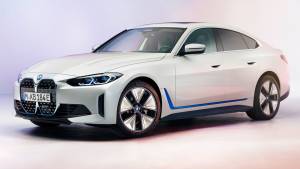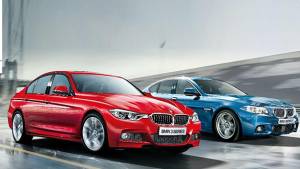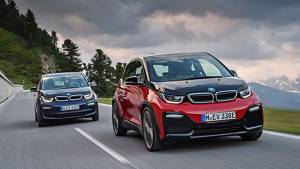2011 preview of the BMW 'i' concept debut
Shumi attended the 2011 preview of the BMW i car concepts. This is a story from that event.
BMW have had enough. Instead of listening to doom and gloom stories about the end of the internal combustion engine and the need to develop alternatives, they are embarking on what is easily the most ambitious alternative fuel vehicle program in recorded history. BMW has been trickling out information about their 'i' project, but the real shape became a lot clearer with the unveiling of the first vehicles of the project, the i3 urban hatchback and the i8 sportscar. Both were presented as concepts at a special event in Frankfurt, followed by a full day of technical briefings. The cars are to set to make their public debut later this year at the Frankfurt International Motor Show.
 i3 concept plan revealed in 2011
i3 concept plan revealed in 2011
Now, automobiles are easily understood today and you rarely need a full day to come to grips with a production car, still less when what you are talking about is a concept of which a miniscule portion will be produced. That too in a watered down form at some point in the future. It's from this point the 'i' project blazes its own trail.
At its very core, the tag line BMW gives the 'i' range isn't Ultimate Electric Driving Machine, but Born Electric. The manufacturer made sure we understood that the 'i' project would be about vehicles and vehicle platforms created specifically for electric and hybrid powertrains. One of the technical sessions demonstrated quite easily how their Active E concept car would suffer with i3's powertrain.
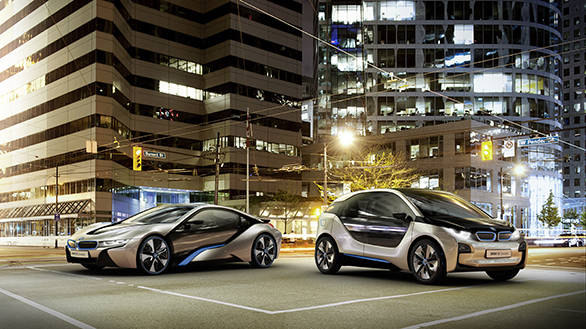 BMW i3 Concept and BMW Concept
BMW i3 Concept and BMW Concept
It would lack space inside, would be startlingly heavy and the driving experience just wouldn't, as a consequence, be something BMW or its customers would appreciate.
Smart cars
Before we go to the cars themselves, there are other critical aspects of this project for the company. Earlier this year, BMW created the BMW i Venture Fund in New York City to invest in and nurture location-aware software for smartphone applications - and you will see why in a minute.
The 'i' cars will be supported by a lot of technology as you might expect. What you will be surprised by is that not all the technology is part of the powertrain or associated electronics. BMW intends to become, in addition to a car maker, a service provider. What services? BMW in association with Sixt, the car rental major, will shortly deploy a fleet of Minis and 1-Series cars across Munich - the city both companies call home. Program members will be able to use their cellphones to accomplish a very cool thing. When they need a car, they will be able to locate and reserve the nearest available car from that fleet off their phones. And having used it and paid for the service (usually by the hour) they will be able to walk away, allowing another subscriber in the system to use that car later. The system will be a test project for one part of the 'i' program.
This isn't a new idea though. A firm called ZipCar successfully offers rentals by the hour to American subscribers, using fixed parking lots across New York City (and the other US cities where it operates) to allow customers to pick and drop off cars. You pay more for bigger cars and pay $25 a year to subscribe. ZipCar also has smartphone app. But in their case, it works more towards reserving a car than finding an available, parked car.
 The i3's unique carbon-reinforced plastic structure
The i3's unique carbon-reinforced plastic structure
BMW's system is internally far more complex and to the user, far more powerful. BMW envisions simple geo-aware services starting from booking tables at a hotel and the ability to locate a car for you as the foundation. BMW is also working on a navigation system that seamlessly talks to your phone and understands that roads and cars are not the sole mobility options open to you. This system will be able to route you so that you get to your destination quickly, through walking, public buses, metro or suburban trains as well as rental 'i' program cars to accomplish mobility. It will also be able to read parking information off the Internet and tell you where to find parking - which according to BMW accounts for 30 per cent of cars on the road in congested city centres.
If you are in an electric car, you will be able to see your range as a circle on a map (with a larger circle for ultra-economy mode), as well as available (and busy) charging stations along with the ability to reserve them. To further leverage current resources, BMW is also working with software firms working on web services that will allow private homeowners to rent out parking and electricity, which will dramatically increase both available parking space and available charging points. We had the opportunity to play with a demo of the app on iPads and it is impressive. Further, BMW say the fact that the car and app can communicate over the Internet also makes possible other things like being able to switch on the aircon before you get to the car, or to have the car be fully charged for a big trip at a certain time in the morning and so forth.
While not directly related to the 'i' project alone, BMW also showed us glimpses of other systems that tie in to these sophisticated cars. There is a fully automatic parking assist program that is being worked on which will substantially do it all by itself. There is traffic jam assistance that can also brake, steer, accelerate and maintain its position in crawling traffic unto 40kmph, allowing the driver to read, play a game while moving through traffic. BMW adds further that intra-vehicle communication and location awareness will also allow the cars to think for themselves and just like computers did for business, they will allow traffic to use roads more optimally, growing a network's capacity to handle traffic far more than physically adding more roads would. Yes, it is strange that a company that prides itself on its enthusiast driver orientation is talking about autonomous cars but as you will see, they haven't completely lost their marbles.
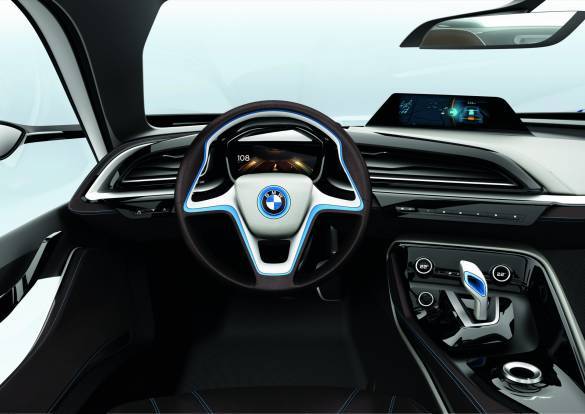 The passenger cabin is super spacious, with new 3D instruments employed to subliminally remind the driver what mode he is driving in
The passenger cabin is super spacious, with new 3D instruments employed to subliminally remind the driver what mode he is driving in
The BMW i3 was first shown as the MegaCity concept and that term is what BMW uses right across the project to represent ever larger metropolises. The i3 was created to host a fully electric powertrain. What it does is separate the car horizontally into the Drive module that is motor, frame, batteries, suspension, wheels etc. And the Life module, which is the passenger cabin and exteriors. BMW calls this LifeDrive architecture and it essentially underpins these two concepts and going forward every car in the 'i' line.
BMW intended the 'i' project in general and the i3 specifically to be as green as humanly possible, which is why they power as much of the Leipzig 'i' production facility with hydro-electric power (a renewable source of energy) and are currently mulling a captive wind farm for the actual assembly operation.
BMW uses lessons learnt from the electric Rolls-Royce 102EX concept to mount the battery in the frame, under the floor of the passenger cabin. It is a BMW, so BMW uses a rear-mounted motor, rear-wheel drive configuration for the i3. Up top, the passenger cabin is super spacious, with new 3D instruments employed to subliminally remind the driver what mode he is driving in apart from all the usual information plus navigation, free parking lots and what have you. There is no transmission, but as an interface element, there is a 'shift' lever on the centre console that you use to start driving.
Looks and styling
The exteriors are breathtaking, using a layered set of surfaces to achieve aerodynamic efficiency as well as ensure that the chap on the road knows you are in a BMW. For the 'i BMW will use a sleek, reshaped kidney grille with blue edging, no slats (not needed!), and loads of glass. BMW i project design head Benoit Jacob and BMW design boss Adrian van Hooydonk both agreed that the all-glass doors would not make production, but 90 per cent of the concept would. In an interesting aside, notice the wheels. The need for efficiency and low rolling resistance, means the wheels have to be large - 17 inches or above! The tyres are thin in cross section, but look great from the sides filling out the arches on both cars rather well.
Engine
The powertrain is all-electric with a 125kW (170PS) electric motor driving the rear wheels and is currently being durability tested. BMW have capped the top speed at 150kmph, which they believe is a good tradeoff between range and use patterns. The car is said to offer a 160kmph range with a full recharge possible in six hours. With a fast charger, says BMW the i3 will be able to gain 80 per cent charge within one hour. Performance? 60kmph should take less than 4seconds and a 100kmph should be possible in 8 seconds.
BMW intends the first production i3 to be ready for sale (or lease, or hourly rental) at the end of 2013 and re-emphasises that it would be a premium product. BMW also answered doubts head on mentioning that they are working on batteries that would last the life of the car. Further, they acknowledged that the synthetic and natural materials and the new production process is more expensive, but even running on the current EU mix of energy sources, the i3 would be cost-effective 55,000km into its life versus the 118d, a hatchback that BMW says is it's greenest, more efficient normal production car.
The i8
The i8 is an equally fascinating proposition. The styling, which sticks close to the Vision EfficientDynamics concept, looks brilliant in the flesh, with the car exuding a calm, but focussed sort of stance, with an incredible slew of shaped panels suggesting (and actually) accomplishing great aerodynamics. BMW claims a drag coefficient of just 2.2, which is lower than the Prius, to pick an example. Like in the i3, the Life module of the i8 is also made of carbon fibre reinforced plastic.
BMW is one of many manufacturers who are working towards making carbon fibre more inexpensive to produce, and they promise that by 2013, you will be able to buy a car with significant amount of it. It is expected that with costs of CFRP coming down and its benefits so obvious, the material will find its way into the normal range of BMW cars as well.
CFRP is a fundamental part of the 'i' project. BMW create the entire passenger cell frame in carbon fibre, bolting it to the Drive module in four places and then glueing it down. The frame is glued together as well and since carbon fibre is a moulded form, the assembly lines will be silent, with no welding or stamping going on. It will be a dramatic change from the noisy assembly lines that are the norm today. The shell then wears thermoplastic exterior panels which are as much as 25 per cent lighter than traditional materials, corrosion-free and on the i8, great looking. The interiors on both the cars, further, boast all manner of clever materials, with recycled PTFE (think mineral water bottle), hemp fibres etc used to furnish the interior. BMW also intends to use secondary and recycled aluminium in the metal parts of the Drive module which also has an impact on overall CO2 emissions.
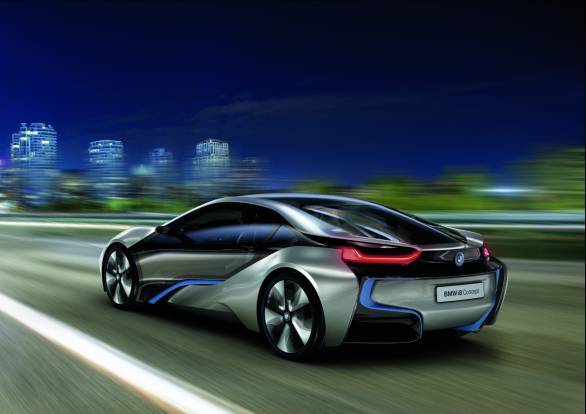 The i8 concept famously made an appearance in the Tom Cruise-starrer Mission Impossible: Ghost Protocol
The i8 concept famously made an appearance in the Tom Cruise-starrer Mission Impossible: Ghost Protocol
Unlike the i3, the i8 is a plug-in hybrid featuring electric motors driving the front wheels and a three cylinder petrol engine driving the rear wheels. The i8 boasts a perfect 50:50 weight distribution, something the manufacturer is obviously kicked about, since it underlines its intention of not losing any of the driving feel the brand is famous for in the transition to new powertrains. The i8 can be a full-electric front wheel driven car for up to 36km, after which the three cylinder petrol engine will kick in to make up for a depleted battery. The combined power rating is 264kW (360PS). Under full bore acceleration, the i8 becomes a powerful four-wheel drive sportscaster, capable of demolishing a 100kmph run in 4.6 seconds, which makes it quicker than an M3 Coupe. Top speed, as usual will be limited to 250kmph. All this and the car claims to be able to return as much as 33kmpl while keeping CO2 emissions down to levels currently unheard of. Part of the credit for the incredible performance is obviously the light weight of the car, with the i8 weighing in at just 1480kg.
The i3 and the i8 were carefully selected to start off the project because they cover the ends of the spectrum. Questioned about the future beyond the 2013 launch, BMW chief Norbert Reithofer quipped that if they have a 3 and an 8, then that leaves a lot of numbers in between to fill. It is expected that BMW will fashion an i5 which will take the Chevrolet Volt head on featuring the i8 powertrain, but probably in a softer state of tune. BMW will also offer a hybrid version of the i3 to customers looking for longer range where a small internal combustion engine will be employed as a range extender, sort of like how the Chevrolet Volt does.
BMW face an interesting future. With fuel running out and the clamour for environmental protection gaining strength, the 'i' project is an ambitious but well-considered response. BMW expect to earn significant portions of their revenue from 'i' cars in the future but there are other challenges as well.
Trends show that youth in the developed world no longer consider owning cars as a solution to personal mobility and they continue to grow less interested perhaps because ownership and the cars themselves are becoming more expensive. BMW's exploration of its role as a service provider, it hopes, will allow it to remain relevant to a customer interested more in arriving at his or her destination than in the mode in which the journey is accomplished. Sales open 2013 and BMW are already working on plans beyond, for the 'i' line of cars, for the services that will go with it and for our Internet enabled vehicular future.
Starts Rs 2.62 Crore
1499cc
Automatic
361
250
-NA-
